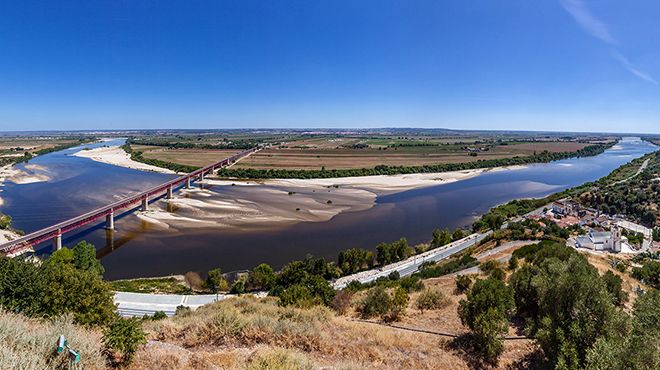From Scalabis to Santarém

From Scalabis to Santarém
Other
The city´s name is related to two legends that are now an important part of the local tradition: the legend of the King Abidis and the legend of Santa Iria (Saint Irene).
Legend of the King Abidis
It is said that Ulysses of Ithaca passed through Lusitania and fell in love with Calypso, the daughter of the Visigothic king Gorgoris. As a result of this encounter, an unwanted child was born, Abidis, who was immediately abandoned at the orders of his grandfather.
He was placed in a basket and thrown into the River Tagus. Miraculously, the basket was carried upstream against the current and washed ashore on the beach at Santarém, where it was picked up by a she-wolf, who fed and protected Abidis.
After a series of unexpected adventures, the son was finally recognised by his mother Calypso, who made him her legitimate heir, choosing the site of Santarém as the capital of the kingdom. He called it Esca Abidis (meaning the food of Abidis), which was corrupted popularly to form the name Scalabis. For the Romans, the town was known as Scalabicastrum.
Even today, this original name has continued into the Portuguese language as the name for the city´s inhabitants, who are known as "escalabitanos".
Legend of Santa Iria
At the end of the 7th century, the town was given the name of "Santa Irena".
This name was later adopted by the Moors as Chanterein or Chantarim, which was then altered to form the name of Santarém.
This fact is said to be due to the story of Santa Iria (Saint Irene). Iria was a devout nun at the Benedictine convent of Nabância (Tomar). Having fallen victim to a certain passion for her spiritual guide, the monk Remígio, she was obliged to drink a tisane, which caused her belly to swell up, a fact that was noted by everybody and taken as a sign that she was pregnant. But there was a young pagan who had also become interested in Iria. Unable to have his loved one, he ordered her to be killed as she was praying by the banks of the River Nabão, a tributary of the River Tagus.
Although the crime was discovered and the criminals repented, they did not manage to find the martyr´s body, which was carried away by the river.
On visiting Santarém in 1324, Queen Isabel was informed in visions of the exact spot where the body of Santa Iria had been washed ashore, having been carried by the River Nabão to the banks of the River Tagus at the foot of the city.
When her husband, the king D. Dinis, heard of this fact, he immediately decided to mark the place of burial with a monument.
In 1644, the Council Senate placed a stone sculpture on top of this monument in homage to the saint.
Due to its location, a hydrometer was added to the monument to record the river´s water levels.
Legend of the King Abidis
It is said that Ulysses of Ithaca passed through Lusitania and fell in love with Calypso, the daughter of the Visigothic king Gorgoris. As a result of this encounter, an unwanted child was born, Abidis, who was immediately abandoned at the orders of his grandfather.
He was placed in a basket and thrown into the River Tagus. Miraculously, the basket was carried upstream against the current and washed ashore on the beach at Santarém, where it was picked up by a she-wolf, who fed and protected Abidis.
After a series of unexpected adventures, the son was finally recognised by his mother Calypso, who made him her legitimate heir, choosing the site of Santarém as the capital of the kingdom. He called it Esca Abidis (meaning the food of Abidis), which was corrupted popularly to form the name Scalabis. For the Romans, the town was known as Scalabicastrum.
Even today, this original name has continued into the Portuguese language as the name for the city´s inhabitants, who are known as "escalabitanos".
Legend of Santa Iria
At the end of the 7th century, the town was given the name of "Santa Irena".
This name was later adopted by the Moors as Chanterein or Chantarim, which was then altered to form the name of Santarém.
This fact is said to be due to the story of Santa Iria (Saint Irene). Iria was a devout nun at the Benedictine convent of Nabância (Tomar). Having fallen victim to a certain passion for her spiritual guide, the monk Remígio, she was obliged to drink a tisane, which caused her belly to swell up, a fact that was noted by everybody and taken as a sign that she was pregnant. But there was a young pagan who had also become interested in Iria. Unable to have his loved one, he ordered her to be killed as she was praying by the banks of the River Nabão, a tributary of the River Tagus.
Although the crime was discovered and the criminals repented, they did not manage to find the martyr´s body, which was carried away by the river.
On visiting Santarém in 1324, Queen Isabel was informed in visions of the exact spot where the body of Santa Iria had been washed ashore, having been carried by the River Nabão to the banks of the River Tagus at the foot of the city.
When her husband, the king D. Dinis, heard of this fact, he immediately decided to mark the place of burial with a monument.
In 1644, the Council Senate placed a stone sculpture on top of this monument in homage to the saint.
Due to its location, a hydrometer was added to the monument to record the river´s water levels.




 Explore
Explore 
 Remember and Share
Remember and Share 


